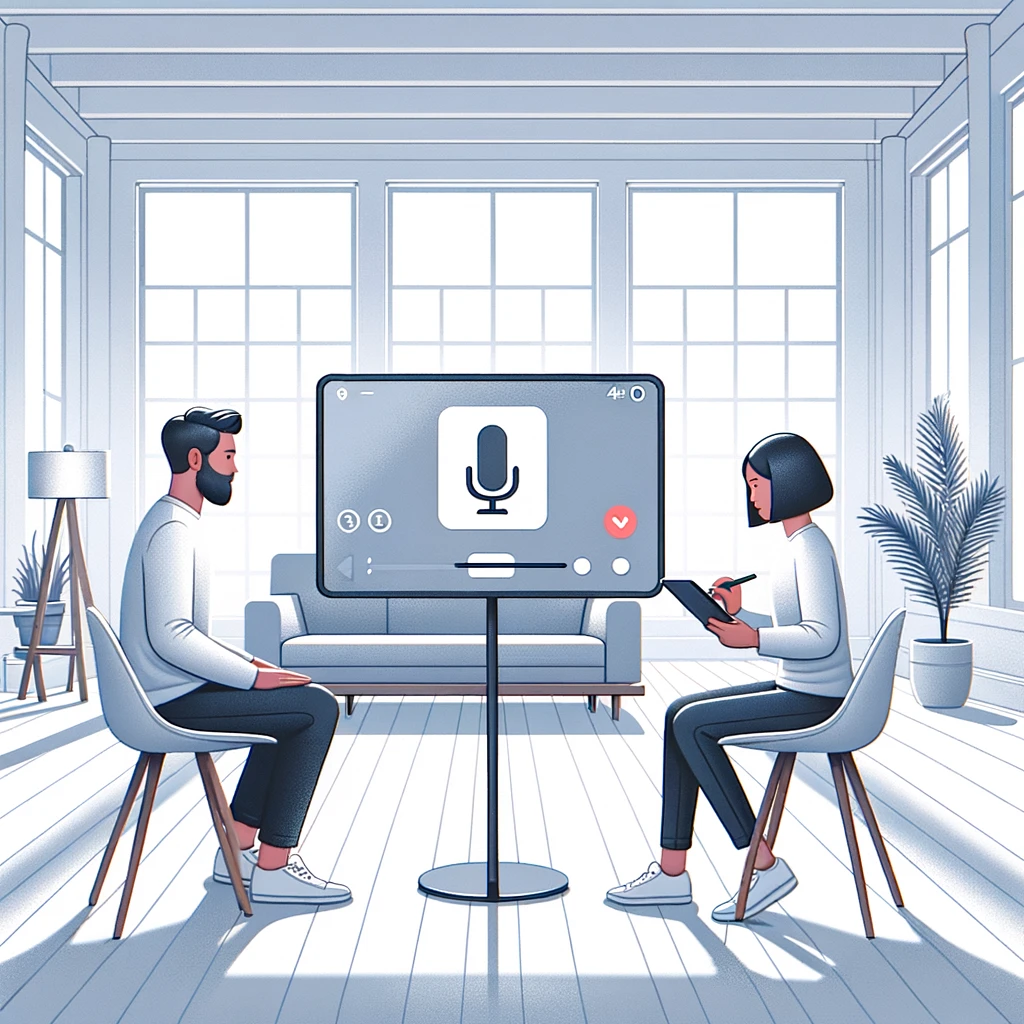Video feedback can be a valuable tool for businesses of all sizes. By collecting and analyzing video feedback from customers, you can gain insights into their needs and pain points, improve your products and services, and build stronger customer relationships.
1. Use video customer feedback analysis tools like ScreenApp, Dovetail, or UserTesting
Video customer feedback analysis tools are the best way to collect, manage, and analyze customer feedback. These tools make it easy to capture customer feedback in real time, and they provide a variety of features to help you make sense of the data.
One of the best video customer feedback tools on the market is ScreenApp. ScreenApp offers a wide range of features, including:
- AI Screen recording: Record customers’ screens as they use your product or service. This can help you identify usability issues and improve the customer experience.
- Video transcription: Get transcripts of your video feedback so you can easily search and analyze the data.
- AI video notetaker: take full and detailed notes of your customer interviews and support videos to ensure you’re organised
- Feedback Summarizer: Understand the key points of your customer feedback so you can identify positive and negative trends.
ScreenApp is also very easy to use. To get started, simply create an account and invite your customers to participate. Once your customers have signed up, they can start recording their feedback immediately.
If you’re looking for a video customer feedback tool that can help you improve your products and services, then ScreenApp is the perfect solution for you.
2. Ask customers to record themselves using your product and share their feedback
Video feedback is a powerful tool that can help you improve your product and customer experience. When customers record videos of themselves using your product, you can see firsthand how they are using your product and what features they find most useful. This information can help you identify areas where you can improve your product, such as making it more user-friendly or adding new features, as guided by feature request tools.
Here are some tips for asking customers to record videos of themselves using your product:
- Make it easy for customers to record videos. You can provide customers with a link to a video recording tool or send them instructions on how to record a video on their own device.
- Give customers clear instructions. Tell customers what you want them to record in their video and how long you want the video to be. Use a work instructions template or software like the one from SweetProcess to organize the guidelines in a clear way.
- Incentivize customers to record videos. You can offer customers a discount on their next purchase or a chance to win a prize for recording a video.
- Promote your video feedback program. Let customers know that you are collecting video feedback and why you are collecting it. Being transparent about data usage aligns with consent-based marketing principles, ensuring customers feel comfortable sharing their experiences. You can promote your video feedback program on your website, social media, and in your marketing materials. website, social media, and in your marketing materials.
Once you have collected video feedback from customers, be sure to watch the videos and take the time to understand what customers are saying. This feedback can help you make informed decisions about how to improve your product and customer experience.

Record you user feedback
3. Ask satisfied customers to record video testimonials about their experiences with your company
Video testimonials are one of the most powerful marketing tools you can use to build trust and credibility with potential customers. When satisfied customers share their positive experiences with your company in a video format, it shows potential customers that you are a real and reliable business.
In fact, a recent study found that 92% of consumers trust video testimonials more than other forms of marketing content. And, 85% of consumers say that they are more likely to buy a product from a company after watching a video testimonial.
If you’re not already collecting video testimonials from your customers, you’re missing out on a huge opportunity. Here are a few tips for getting started:
- Identify your best customers. Who are the customers who are most enthusiastic about your products or services? Reach out to them and ask if they would be willing to record a video testimonial.
- Make it easy for customers to record their testimonials. You can provide customers with a sample testimonial script and some tips for recording a good video. You can also offer to help them record their testimonial in person or remotely.
- Promote your video testimonials on your website and social media channels. Once you have some video testimonials, be sure to share them on your website and social media channels. You can also use them in your email marketing campaigns and paid advertising campaigns. Automated email marketing helps you consistently deliver those testimonials to the right audience, without adding extra manual work.
By collecting and promoting video testimonials from your customers, you can build trust and credibility with potential customers and increase your sales.
4. Conduct video interviews with customers to get in-depth feedback on their needs and pain points
Video interviews are a powerful tool for businesses of all sizes. By interviewing customers on video, you can gain in-depth feedback on their needs and pain points. This feedback can be used to improve your products and services, develop new offerings, and create a better customer experience.
Here are some tips for conducting video interviews with customers:
- Choose the right customers to interview. Select customers who are representative of your target audience and who have a variety of experiences with your product or service.
- Prepare for your interviews. Develop a list of questions that you want to ask, but be flexible enough to follow up on unexpected insights.
- Create a comfortable and welcoming environment. Be sure to have a quiet and well-lit space for your interviews.
- Start by building rapport. Ask a few general questions to get to know your customer and make them feel comfortable.
- Ask open-ended questions. Avoid asking yes/no questions. Instead, ask questions that encourage your customer to share their thoughts and experiences in detail.
- Listen attentively to your customer’s responses. Don’t interrupt, and be sure to follow up on any important points.
- Thank your customer for their time. At the end of the interview, thank your customer for their participation and let them know how their feedback will be used.
Once you have conducted your video interviews, you can start to analyze the feedback. Look for common themes and trends. What are your customers’ biggest needs and pain points? What are they looking for in a product or service like yours?
5. Record customer support videos to help customers resolve common issues and troubleshoot problems
Customer support videos are a powerful tool for businesses of all sizes. They can help you reduce the number of support tickets you receive, improve the customer experience, and boost customer satisfaction.
When customers can find and watch videos that explain how to resolve common issues on their own, they’re less likely to contact your support team. This can free up your contact center team to focus on more complex issues and provide better service to all of your customers. Many organizations use contact center QA software to identify which issues most frequently require agent assistance, helping them prioritize which support videos to create first. An invaluable addition to enhancing customer interactions can be found in employing tools like outbound sales software, which can streamline communication efforts and facilitate proactive engagement with your customer base.
Abacus BPO can further support this by providing customer support which enhance the customer experience by providing a self-service option within a cloud contact center. Customers can watch videos at their own convenience and at their own pace, and they can rewind or re-watch videos as needed. This can lead to a more positive and satisfying customer experience.
Here are some tips for recording customer support videos:
- Choose the right topics for your videos. Focus on the most common issues that your customers experience.
- Keep your videos short and to the point. Aim for videos that are no longer than 2-3 minutes long.
- Use clear and concise language. Avoid using jargon or technical terms that your customers may not understand.
- Provide step-by-step instructions. Show customers exactly how to resolve each issue.
- Use high-quality video and audio. Make sure that your videos are well-lit and that the audio is clear.
Once you have recorded your customer support videos, be sure to make them easy for customers to find. Publish your videos on your website and social media channels, and consider embedding them in your support knowledge base. Utilizing a comprehensive knowledge base software could make this process even more efficient, ensuring customers quickly find the right video assistance they need.
By following these tips, you can create customer support videos that will help you reduce support tickets, improve the customer experience, and boost customer satisfaction.
6. Use video surveys to collect feedback from customers about their satisfaction with your products or services
Video surveys are a powerful tool for collecting customer feedback that is both engaging and informative. By using video to capture your customers’ thoughts and opinions, you can gain deeper insights into their experiences and needs.
Here are a few tips for creating effective video surveys:
- Ask clear and concise questions. Your questions should be easy to understand and answer, and they should be tailored to the specific feedback you are trying to collect. For example, instead of asking “How satisfied are you with our product?”, you could ask “What did you like most about our product? What did you like least?”
- Use high-quality video and audio. Your video survey should be visually appealing and easy to watch. Use high-quality video and audio recording equipment, and make sure to edit your survey to remove any unnecessary footage.
- Keep your survey short and to the point. Customers are more likely to complete a short video survey than a long one. Aim to keep your survey under five minutes long, and focus on asking the most important questions.
- Make it easy for customers to participate. Provide your customers with clear instructions on how to complete your video survey. You may also want to offer an incentive for completing the survey, such as a discount on their next purchase or a chance to win a prize. Also, make video feedback easily accessible to your customers. You can generate QR code and embed the video feedback to make it easily shareable. Incorporating user-friendly tools like Uniqode’s QR Code generator can streamline this process, as it allows you to create customized, branded QR codes quickly and easily. This enables your customers to scan and provide feedback effortlessly, enhancing the overall user experience.
Once you have collected your video survey responses, be sure to analyze the data carefully. Look for common themes and trends, and use this information to improve your products and services.
7. Conduct video focus groups to get feedback from a group of customers on a specific topic
Video focus groups are a powerful tool for businesses of all sizes to collect feedback from their customers. By providing a platform for customers to share their thoughts and experiences in a group setting, video focus groups can help businesses to:
- Gain insights into customer needs and pain points
- Identify new product and service opportunities
- Understand customer perceptions of their brand
- Generate ideas for marketing and advertising campaigns
To maximize the effectiveness of your video focus groups, it is important to choose a topic that is relevant to your customers and to facilitate the discussion in a way that encourages everyone to participate. Here are a few tips:
- Choose a topic that is specific and actionable. Instead of asking customers for their overall feedback on your product, focus on specific features or functionality they frequently use. For example, an online jewelry store could ask for feedback on the augmented reality jewelry feature that lets customers virtually try on pieces. This approach helps gather targeted insights into a key part of the shopping experience, enabling businesses to make more informed decisions.
- Recruit a diverse group of participants. The more diverse your group is, the more different perspectives you will be able to gather.
- Create a comfortable and welcoming environment. Make sure that all participants feel comfortable speaking up and sharing their ideas.
- Ask open-ended questions. Avoid asking questions that can be answered with a simple yes or no. Instead, ask questions that encourage participants to elaborate on their thoughts and experiences.
- Be a good listener. Actively listen to what participants are saying and ask follow-up questions to clarify their points.
- Summarize key takeaways at the end of the focus group. This will help to ensure that everyone is on the same page and that the key findings of the focus group are not lost.
8. Ask customers to record themselves using your website or app and share their feedback
This is a great way to improve the usability of your website or app. By watching how customers interact with your product, you can identify areas where they are getting stuck or confused. You can then use this feedback to make changes that will make your product easier to use and more enjoyable for your customers.
Here are a few tips for collecting and analyzing video feedback from customers:
- Make it easy for customers to record and submit their feedback. You can use a video feedback tool like ScreenApp or Dovetail to create and share surveys that allow customers to record their feedback directly in their browser.
- Ask customers to record themselves performing specific tasks on your website or app. This will help you to identify specific usability issues.
- Ask customers to share their overall thoughts and feedback on your website or app. This will help you to get a better understanding of how customers perceive your product and what improvements you can make.
- Analyze your video feedback carefully to identify common usability issues and trends. Once you have identified these issues, you can start to make changes to your website or app to improve the user experience.
9. Encourage customers to record video reviews of your products or services
Video reviews are a powerful way to influence potential customers’ purchase decisions. According to a recent study, 92% of consumers said that they trust video reviews more than traditional text reviews. This is because video reviews allow customers to see and hear from real people who have used your products or services, which can help them to make more informed purchase decisions.
If you’re looking to boost sales, encouraging customers to record video reviews is a great way to do it. Here are a few tips:
- Make it easy for customers to record video reviews. Provide them with clear instructions and guidelines on how to record and submit their reviews. You can also create a dedicated landing page for video reviews on your website. Just make sure to use page order WordPress to easily organize and prioritize your landing pages, ensuring that the video review page is easily accessible to visitors.
- Incent customers to leave video reviews. Offer customers a discount on their next purchase or a chance to win a prize in exchange for recording a video review.
- Promote customer video reviews on your website and social media channels. Share video reviews on your website, social media pages, and email marketing campaigns. To maximize the reach of these video reviews, many businesses also work with digital marketing experts like SeoProfy.com to ensure their content gets proper search engine visibility and drives more traffic to their testimonials. You can also use video ads to promote customer video reviews on YouTube and other video-sharing platforms.
10. Monitor social media for video feedback from customers
Social media is a powerful tool for businesses of all sizes. It can be used to connect with customers, promote products and services, and gather valuable feedback. One of the best ways to use social media to collect feedback is to monitor for video feedback.
Video feedback is a great way to learn about the customer experience firsthand. Customers are often more likely to share their honest opinions in a video than they would in a text-based format. Additionally, video feedback can be more informative, as it can provide you with visual cues that can help you to understand the customer’s experience.
To monitor social media for video feedback, you can use a variety of tools and techniques. One simple way is to simply search for your brand name and product or service name on social media platforms like Twitter, YouTube, and Instagram. You can also use social listening tools to track mentions of your brand and products or services across social media.
Once you have found video feedback from customers, be sure to watch it carefully and take notes. Pay attention to what customers are saying about your products or services, what they like and dislike, and any suggestions they have for improvement. You can then use this feedback to improve your products and services, as well as your marketing and customer service.






